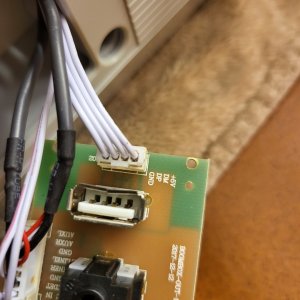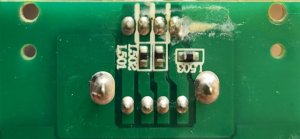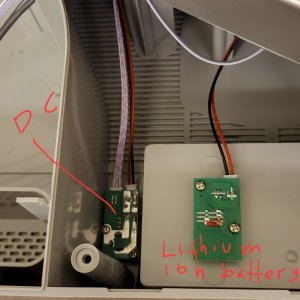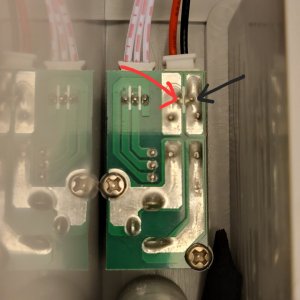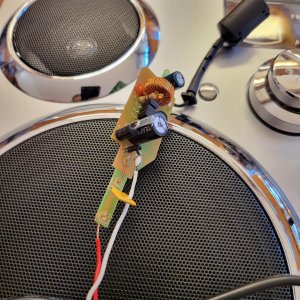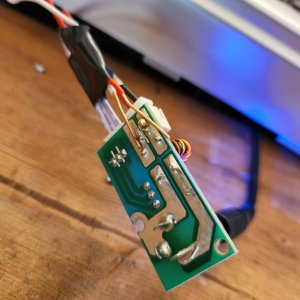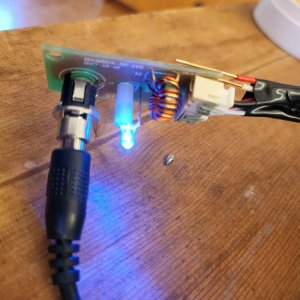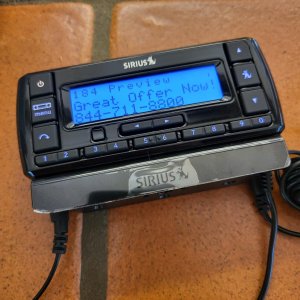Greetings everyone. Still learning to navigate this forum so I'm not sure I'm in the right place to ask. Reaching out to anyone if they can give me some insight on how to provide constant power to the USB port on the GPO Brooklyn boombox. I want to listen to a Sirius XM Stratus 7 receiver. The GPO has Line In already and I'll just mount the magnetic antenna from the Stratus 7 receiver on top of the boombox. I just need power to the USB port on the boombox. I bought a USB power cable made for the Stratus 7 receiver but the GPO USB port only has power when the dial selector is turned to USB. When the dial is set to AUX IN to listen to the satellite radio, the power is disconnected from the USB port thus not being able to power my Sirius receiver. I have zero knowledge and no schematics available for the GPO. I can send detailed photos.
GPO Brooklyn USB port power supply issue
- Thread starter NotJohnCusacksBoombox
- Start date
You are using an out of date browser. It may not display this or other websites correctly.
You should upgrade or use an alternative browser.
You should upgrade or use an alternative browser.
- Status
- Not open for further replies.
Hopey, thank you. Now I'll have to figure out what you just said haha! Would you be able to point me out exactly where we're talking about if I sent photos? I can send an overall view of the interior and we can zoom in from there? It's pretty empty inside compared to the vintage boxes.
Thank you, Hopey. It's a good start for me to learn. I just bought Forest M. Mims II getting started guide and will be looking into other resources to learn. I currently have 36 vintage boomboxes (and counting) that will need attention. Retirement hobby.
Last edited:
hopey
Inactive
Even though the Supply is disconnected the data from the USB may trigger the daisy chain and switch off Line IN or worse make it smoke.Thanks, Floyd! or disconnect the existing and wire direct? I can't foresee needing 2 USBs.
Even though the Supply is disconnected the data from the USB may trigger the daisy chain and switch off Line IN or worse make it smoke.
Ok. Is it possible to wire the car cigarette lighter power cord (after disassembly) supplied with the satellite radio straight into the boombox?
hopey
Inactive
Sure just need to pickup 12v off the power supplyOk. Is it possible to wire the car cigarette lighter power cord (after disassembly) supplied with the satellite radio straight into the boombox?
floyd
Boomus Fidelis
That's how I would do it all you have to do is tap into the power supply.Ok. Is it possible to wire the car cigarette lighter power cord (after disassembly) supplied with the satellite radio straight into the boombox?
That's how I would do it all you have to do is tap into the power supply.
Literally, soldering the satellite radio power cord to the DC points in the following photo? I won't be using battery power since this is mainly a garage radio.
Attachments
hopey
Inactive
I think so turn it on and check the volts. So it doesn't have a AC Transformer?Literally, soldering the satellite radio power cord to the DC points in the following photo? I won't be using battery power since this is mainly a garage radio.
I'll get back to this later next week. I just left out of town. Thank you for the replies so far.
The innards are pretty bare. I could hide my kids in there. I'll pick up a volt meter in the meantime.I think so turn it on and check the volts. So it doesn't have a AC Transformer?
DO NOT use a voltage divider circuit as a power supply, certainly not for a device like a satellite radio receiver. That is horrible advice. For one, you simply can not figure out the necessary resistors without knowing the operating resistance of the "load" which is your sirius receiver. My experience with satellite radios is that they consume quite a bit of power, far more than a negligible amount. Even if you knew what that resistance was and could calculate the necessary ratio to come up with a 5V output, it would be a terribly inefficient power supply as it would shunt quite a bit of current down the drain. Then comes voltage; voltage divider circuit are very sensitive to varying loads. Different stations alone could impart a change in current draw. With each change in current, the voltage will likewise shift. Most digital circuits require a stable 5V supply. You simply won't get it with a voltage divider circuit unless it is used to power, for example, a transistor bias circuit which consumes in the milliamps. Do some research on voltage divider power supply first, you'll find this to be true. A far better solution is to simply devise a voltage regulator circuit instead. This can drop the voltage safely from 12V (or almost anything a boombox can provide) to 5V and provide a stable supply at that. You can use either a simple voltage regulator IC (i.e. 7805) which requires only a modest number of complimentary support components or buy an off the shelf "buck converter regulator." These are small postage stamp sized regulator modules that you can get on ebay for only a few dollars. The IC regulator is a simpler circuit and more reliable with low noise compared to the buck converter regulator which being a switching circuit could potentially introduce noise. On the other hand, buck converters are cheap, requires no designing on your part, and simple to integrate into your circuit.
Lastly. You can test voltage in a divider circuit with a meter. Just keep in mind that actual voltage will change once a load is placed into the circuit. For example, if you test a voltage divider circuit with no load and come up with 5v, watch as the voltage drops way way down the moment you connect the radio, perhaps even to zero. You can reduce this effect by using low value resistors, but they will shunt a lot of current to ground, and the lower the resistance rating, the higher the resistor wattage. Have you seen how large 1w, 2w, 5w resistors are? In any case, regardless of resistor value, unless the draw is tiny and the resistors are extremely low value, the radio will always cause the supply voltage to drop once connected. However, if you have a voltage regulator circuit that is suitably sized (amps), the output voltage will always be maintained spot on regardless of current consumption as long as consumption is within range of the regulator. If you decide to use a voltage regulator, keep in mind that many regulators will not be stable without a load. Therefore, it is recommended to maintain a small load which you can add by using a resistor to ground, about 1.5k to 2k should do it. This will provide somewhere around 1.5 - 2.0 mA of load to maintain stability. To be sure, you can always look up the regulators datasheet.
Lastly. You can test voltage in a divider circuit with a meter. Just keep in mind that actual voltage will change once a load is placed into the circuit. For example, if you test a voltage divider circuit with no load and come up with 5v, watch as the voltage drops way way down the moment you connect the radio, perhaps even to zero. You can reduce this effect by using low value resistors, but they will shunt a lot of current to ground, and the lower the resistance rating, the higher the resistor wattage. Have you seen how large 1w, 2w, 5w resistors are? In any case, regardless of resistor value, unless the draw is tiny and the resistors are extremely low value, the radio will always cause the supply voltage to drop once connected. However, if you have a voltage regulator circuit that is suitably sized (amps), the output voltage will always be maintained spot on regardless of current consumption as long as consumption is within range of the regulator. If you decide to use a voltage regulator, keep in mind that many regulators will not be stable without a load. Therefore, it is recommended to maintain a small load which you can add by using a resistor to ground, about 1.5k to 2k should do it. This will provide somewhere around 1.5 - 2.0 mA of load to maintain stability. To be sure, you can always look up the regulators datasheet.
Thanks, Superduper for the info. I have no experience with electronics other than using a soldering iron to fix issues with my kid's toys. I found a similar mod on Instructables.com. Using the satellite radio cigarette lighter power cord to boombox power supply. It seems to be working. What do you think? Do you foresee any issues?
Attachments
If I knew you had a cigarette lighter adapter specifically intended for that receiver, it's what I would have recommended in the first place. Clearly, the receiver is intending to receive 12v - 14.5v through that adapter, which probably has a voltage regulator built into it. Long term reliability? I couldn't say. I would need details: specifications on the receiver, the adapter, the boombox power supply, none of which I'm sure you have, so it's basically a guess. But if it's working, it's probably going to be OK. Cranking the boombox will stress it's power supply and with the additional load by the receiver, that would be the most risky circumstance so keep that in mind. Also, if the adapter is expecting automotive level voltage and your boombox power supply outputs something way out there, like 20v+, then the adapter's life might be shortened. But it's all a guess. These things have a limited life anyway, I would say just use it and enjoy it.
Thanks, Superduper. I'll keep your notes handy. Maybe I'll need to look back on them in the future after I learn some basic electronics. I let the box run for quite a while just to make sure nothing got hot or went up in flames. I won't be cranking it much. Just my 80's tunes. Tomorrow I'll solder everything up.
- Status
- Not open for further replies.


